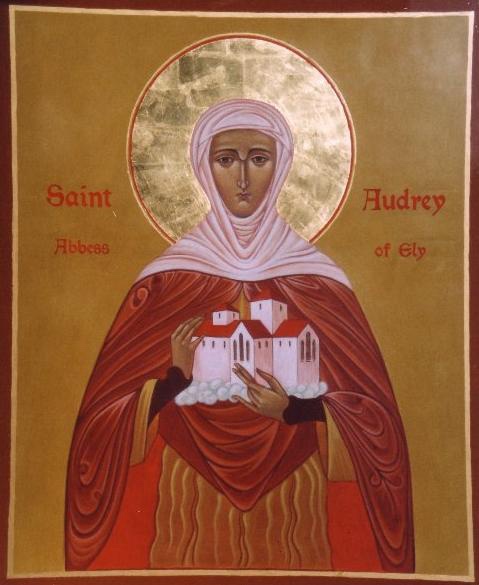
In thee the Image of God was preserved, O noble Audrey, for thou didst take up thy cross and follow Christ. Royal virgin, thou didst teach the multitude by thine example that the flesh is to be scorned as fleeting, while the soul needeth great care as immortal. Wherefore, O holy Audrey, thou dost now make glad with the angels.
VENERABLE ETHELDREDA, ABBESS OF ELY
Commemorated: June 23
Holy Queen St. Etheldreda, Abbess of Ely (AD. 636-679), (Aethelthryth, Audrey) is the most venerated English female saint. A Saint renowned for her perpetual virginity-despite her two marriages!- and glorified by incorruption.
Back on 18th July 2018, the Saint decided to make a powerful entrance into our lives, revealed herself as the patron Saint for our fellowship, and Father J. organically became the fellowship’s spiritual Father.
A powerful entrance indeed! I remember most vividly how we folded various female saints’ names as potential patrons in lots, put them in Father’s skoufia to draw, and when her name was picked and Father started blessing us with holy water, these ‘water’ drops burned, literally so, the surface of the table where the water bowl was placed on! Perplexed we turned to Father to explain to us what was happening, but he bowed and left in silence. God is glorified in His Saints!
What we found most moving in St Etheldreda’s podvig was the central role her spiritual father, St. Wilfrid of York, “the Apostle of Sussex”, played throughout her brief, yet tumultuous and full of suffering, sanctified life. This most powerful Patron Saint, always ready to help everybody in distress, especially married women in trouble with their husbands, humbly obeyed her spiritual father in every step she made and decision she took in her life. A holy rebel and a scandal she was, yet always under an Omoforion and an Epitrahelion!
To begin with, it was her spiritual father, who blessed her vow of chastity at a very young age and guided her during all her patient waiting for 15 or more years, until she would become a nun. (And until she had been twice married!)
St. Wilfrid was such a close adviser to her that Egfrith, hew lawful, second husband —her first husband had already reposed after three years of “marriage” —entreated him to use his influence to induce his wife to become, in fact, what, as yet, she had been only in name. He even promised Wilfrid great things for himself and for his churches, should he be able to persuade the Queen that her duty to God was her duty to her husband. But Wilfrid feigned to enter into the King’s view of the matter, whereas, in fact, he steadfastly encouraged the Queen to persist in her celibate life and even advised her to ask permission to leave the court and become a nun. (Egfrith never forgave him.)
During one of her escapes, it was St. Wilfrid who tonsured her a nun, and later on, when St Etheldreda eventually retreated to Ely and founded a double monastery there with communities for monks and nuns, who lived separately but prayed together in the common church, and became the first Abbess, her spiritual father continued to support her. It was St. Wilfrid who made her abbess and gave the veil to her first nuns. He obtained special privileges for her, from the Pope, and often visited her and helped her with advice and suggestions useful in the management of her large establishment.
We found most moving this strong connection of the Saint with her spiritual Father. Nothing seemed to be able to separate her from him. Through her example, we understood more clearly how essential for all of us and vital in our sanctification is our obedience to a spiritual Father, especially through the sacrament of Confession, in the Church. Especially in times of suffering and temptation, when only the Church, the Saints and your spiritual father can truly support you and be your Rock, your icon of Christ the Rock.
This holy relationship between the faithful and their spiritual Fathers is a pattern we observe in many Celtic women Saints. For example, St Dymphna and her spiritual Father, St Gerebernus, fled together defying the Father King’s immoral demand to marry his daughter, crossed the Channel, and eventually faced martyrdom together. St Winifred and St Beuno is another like Celtic holy pair, where Winifred, from an early age, was instructed in the spiritual life by St. Beuno and lived under his care a chaste life, dedicated to God, until she met her martyrdom. Beuno took Winifred’ head and replaced it to her body, then prayed to God that she be restored whole. By St. Beuno’s prayers, Winifred came back to life. This miracle was just one of many in their holy relationship and life together until their glorification.
St Etheldreda, a queen and most powerful lady, is setting a clear example to us how important it is to endure the martyrdom of the dying of our will in our obedience to our spiritual father, in order to overcome our fallen nature, our old self, our tendency to become autonomous, form our own opinions, and become thus self-centred rather than God-centred. In all our life’s decisions, momentous or ‘small’. St Etheldred, the Saint and queen, may have abandoned two husbands but understood all too well that following our conscience and not acting in obedience, even in our most ‘pious’ endeavours, is a very tricky path and most of the times, if not all, the beginning of prelest.
By C.
